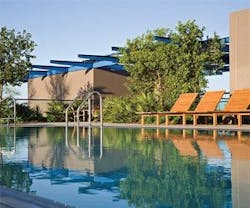Green Roofs: A Cool Choice
Green roofs, which include vertical landscapes, greenwalls, and rooftop gardens, are playing an important role in the development of LEED-certified buildings. These on-structure gardens create new microclimates and are an easy, effective way to beautify the built environment while enhancing a building’s energy efficiency.
Today, podium-level gardens are being incorporated into virtually every type of commercial structure: high-rise offices, hotels and resorts, residential, mixed-use, and retail properties. Green roof technology has advanced quickly, and architects and building owners have increasingly embraced the value of sustainability in their developments.
There are three types of rooftop gardens: 1) intensive, an accessible, park-like roof garden with conventional trees and plants requiring irrigation, feeding, and maintenance; 2) extensive, a traditional blanket of green material like sedum or select ornamental grasses or ground covers, not accessible to the general public, requiring little maintenance; and 3) semi-intensive, which is a combination of both.
Here’s a look at three recently installed green roofs and roof gardens around the nation:
Eaton Vance Corp., BostonEaton Vance Corp., a Boston-based investment firm, relocated its headquarters to the Financial District in downtown Boston. This 310,000-square-foot office building underwent a full retrofit, including the addition of an outdoor entertaining space and landscaped roof deck. An intensive roof garden affords employees and their visitors breathtaking views of Boston Harbor and the newly constructed Rose F. Kennedy Greenway. The 13th-floor green roof includes square and round precast concrete planters filled with Skyline Honey Locust trees, as well as 200 perennials and a 350-square-foot blanket of sedum material.
Optima Biltmore Towers, Phoenix
Optima Biltmore Towers helped transform the Phoenix skyline with its environmentally friendly design. A green roof caps the towers where a trellised sky bridge links luxurious condominiums to a recreation area, offering residents a unique, natural view. The property integrates solar systems that complement an environmentally sensitive green roof and retreat. The landscape and irrigation includes a pool and spa, as well as arbors for shade. Using specially blended, lightweight soil shipped from Utah, nearly 300 boxed trees and 2,000 shrubs were planted on the 17th floor.
ProLogis, Denver
ProLogis, one of the largest global providers of warehouse and distribution space, is also a pioneer in the LEED building movement. ProLogis expanded and added a rooftop garden bridge above an atrium that connects two buildings together at a Denver-area campus, a project that’s registered as LEED Silver and awaiting certification by the U.S. Green Building Council (USGBC).
Plants and trees native to the region were planted in a 16-inch-deep tray; a special drip irrigation system runs from inside the building and distributes water directly to the root of the plants. Pavers, made from recycled concrete onsite, line the walkways for pedestrians.
These green solutions are prime examples of how green roofs can help bring nature closer to urban settings, improve insulation and air quality, and work to deliver economic and social benefits to communities.
Kelly F. Duke is vice president, pre-construction services, at Calabasas, CA-based ValleyCrest Landscape Development.
